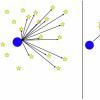Mechanisms of Mitochondrial Fission and Fusion "The fraction of mitochondria that are fused depends on the relative rates of fission and fusion." The fusion/fission ratio changes with circumstances (and in different tissues). Starvation (AMPK CR) increases fusion. Unintuitively low-level toxins increase fusion even though mitochondrial damage increases fission. This following proteins control fission/fusion
Interesting, and rather odd.
I looked up the paper and found this: "Two opposing trends in fission and fusion rates are used to counter different levels of stress: increased fusion and/or decreased fission helps overcome low levels of stress, whereas decreased fusion and/or increased fission occurs with high levels of stress. Low levels of stress are seen with starvation, during which mitochondrial fission is inhibited to protect cells from excessive autophagosomal degradation of mitochondria (Gomes et al. 2011; Rambold et al. 2011)."
We seem to be getting contradicting reports on fasting.
This might be consistent with Longo's reports of fasting protecting healthy cells during chemotherapy.
But I'm getting confused by the seeming contradictions regarding calorie intake and fission/fusion.
Thoughts, anyone?
I think fasting should protect healthy cells in chemotherapy, because it will reduce the ROS produced my mitochondria.
Even all healthy mitochondria with a body in perfect shape and optimal levels of nutrients should reach a point, where
they can't neutralize the super oxide produced in complex I - might be pretty normal under realistic conditions.
The oxidative stress is essential for the chemotherapy, because you want the cancerous cells to die from it (or more easily),
but of course, it's an side effects affecting all the healthy cells, too.
The high NAD+/NADH ratio means energy shortage and will uncouple OXPHOS and (from what I understand) is so effective, because it is normally a signal of very high effort. The exercise amplifies this.
Is it possible ratios are high are normally very hard to reach? Could be possible, as the amounts of precursors (NAA, ribose) are pretty high, especially on an empty stomach with activation of NAMPT (through SIRT1). If high ratio means low energy, does this especially high ratio also signalize there's generally an excellent provision of food and it's time for fission? Or do they do it to re-couple OXPHOS?
As both conditions (coupling/uncoupling) go hand in hand with voltage of the membrane, a newly fissioned mitochondrion which is damaged, regarding it's DNA or membrane condition, won't be able to effectively re-couple OXPHOS and thus the membrane potential will stay low (or vice versa).
This mechanism is also used by the cell for the innate immune response (actually they are pretty much the same) Pathogens entering the cell will uncouple OXPHOS, by quickly changing membrane potential. Influx of nutrients (I think also other things)into mt will be disturbed, changing the important ratios. The quicker the pathogen acts, the more it will disturb the happenings in the cytosol and the faster ratios in mt will change. As a result, uncoupling will be stronger and ROS generation also more strong. Best case, the ROS kill the pathogen(s), before apoptosis is initiated. In this case the cell will repair itself. I guess the fission is also the cell's/mitochondria's way to modulate oxidative load. If mitochondria could not fission in this situation, their re-coupling would be much harder, while some of the damage could never be undone.
This is the oldest weapon of the immune system and at it's core it's the same for all stress (physical, chemical, bacterial, viral...).
It fights the stressors, but it can also damage the body and will, if the stress is too strong and/or doesn't end.
Has the best cost-benefit relation in better adapting tissue like muscle (which as one reason, can divide), but is less good in nervous tissue, which is very dependent on energy and harder to repair.
Also the reason I didn't try it yet: As described by others it seems to does work fine for muscles (and other tissues as it sounds), but what will be happening in already weakened neurons or astroglia?
I think this paper gives a good idea of the described: http://www.sciencedi...567724913002390

































 This topic is locked
This topic is locked































